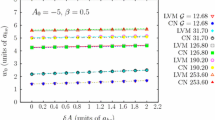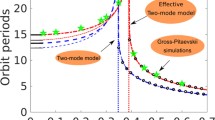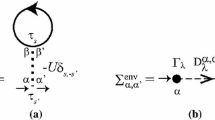Abstract
Near equilibrium, the rate of relaxation to equilibrium and the transport properties of excitations (bogolons) in a dilute Bose-Einstein condensate (BEC) are determined by three collision integrals,  ,
,  , and
, and  . All three collision integrals conserve momentum and energy during bogolon collisions, but only
. All three collision integrals conserve momentum and energy during bogolon collisions, but only  conserves bogolon number. Previous works have considered the contribution of only two collision integrals,
conserves bogolon number. Previous works have considered the contribution of only two collision integrals,  and
and  . In this work, we show that the third collision integral
. In this work, we show that the third collision integral  makes a significant contribution to the bogolon number relaxation rate and needs to be retained when computing relaxation properties of the BEC. We provide values of relaxation rates in a form that can be applied to a variety of dilute Bose-Einstein condensates.
makes a significant contribution to the bogolon number relaxation rate and needs to be retained when computing relaxation properties of the BEC. We provide values of relaxation rates in a form that can be applied to a variety of dilute Bose-Einstein condensates.




Similar content being viewed by others
References
C. Cercignani, Theory and Application of the Boltzmann Equation (Elsevier, New York, 1975)
E.D. Gust, L.E. Reichl, Phys. Rev. E 79, 031202 (2009)
L.E. Reichl, A Modern Course in Statistical Physics, (Wiley-VCH, Mannheim, 2009)
E.A. Uehling, G.E. Uhlenbeck, Phys. Rev. 43, 552 (1933)
E.D. Gust, L.E. Reichl, Phys. Rev. E 81, 061202 (2010)
T.R. Kirkpatrick, J.R. Dorfman, J. Low Temp. Phys. 58, 301 (1985)
T.R. Kirkpatrick, J.R. Dorfman, J. Low Temp. Phys. 58, 399 (1985)
T.R. Kirkpatrick, J.R. Dorfman, J. Low Temp. Phys. 59, 1 (1985)
M.J. Bijlsma, E. Zaremba, H.T.C. Stoof, Phys. Rev. A 62, 063609 (2000)
E. Zaremba, T. Nikuni, A. Griffin, J. Low Temp. Phys. 116, 277 (1999)
A. Griffin, T. Nikuni, E. Zaremba, Bose-Condensed Gases at Finite Temperatures (Cambridge University Press, Cambridge, 2009)
E.D. Gust, L.E. Reichl, e-print arXiv:1202.3418 (2012)
P.B. Blakie, A.S. Bradley, M.J. Davis, R.J. Ballagh, C.W. Gardiner, Adv. Phys. 57, 363 (2008)
A.L. Fetter, J.D. Walecka, Quantum Theory of Many-Particle Systems (Dover, New York, 2003), pp. 314–319
E.A. Frieman, J. Math. Phys. 4, 410 (1963)
S. Peletminskii, A. Yatsenko, Sov. Phys. JETP 26, 773 (1968)
A.I. Akhiezer, S.V. Peletminskii, Methods of Statistical Physics (Pergamon, Oxford, 1981)
I. Kuščer, M.M.R. Williams, Phys. Fluids 10, 1922 (1967)
V.N. Popov, Functional Integrals and Collective Modes (Cambridge University Press, New York, 1987)
R.J. Dodd, M. Edwards, C.W. Clark, K. Burnett, Phys. Rev. A 57, R32 (1998)
D.A. Hutchinson, E. Zaremba, A. Griffin, Phys. Rev. Lett. 78, 1842 (1997)
K. Burnett in Bose-Einstein Condensation in Atomic Gases, ed. by M. Inguscio, S. Stringari, C.E. Wieman (IOS Press, Washington, D.C., 1999), pp. 273–283
S.A. Gardiner, S.A. Morgan, Phys. Rev. A 75, 043621 (2007)
M.H. Anderson, J.R. Ensher, M.R. Mathews, C.E. Weiman, E.A. Cornell, Science 269, 198 (1995)
D.J. Heinzen in Bose-Einstein Condensation in Atomic Gases, ed. by M. Inguscio, S. Stringari, C.E. Wieman (IOS Press, Washington, D.C., 1999), p. 385
B. Shizgal, Can. J. Phys. 62, 97 (1984)
D. Kahaner, C. Moler, S. Nash, Numerical Methods and Software (Prentice-Hall, Englewood Cliffs, 1989), pp. 153–157
Acknowledgements
The authors wish to thank the Robert A. Welch Foundation (Grant No. F-1051) for support of this work.
Author information
Authors and Affiliations
Corresponding author
Appendix: The Form of the Kernels Used in Computation
Appendix: The Form of the Kernels Used in Computation
To calculate the values of the kernel K l (c 1,c 2) in Eq. (35), we split the calculation into six parts, one for each of the individual kernels in Eqs. (25)–(28). In this appendix, we show how to obtain an expression that is well-suited to numerical quadrature for the kernel \(Q_{A}^{l}(c_{1}, c_{2})\). Similar procedures can be used with the other five kernels as well. We begin with the definition

First let us perform the integration over c 4,

The resulting integrand only depends on the magnitude of c 4, where c 4=|c 1+c 2−c 3|. We now perform the integration over c 3 in spherical coordinates, with the z-axis oriented parallel to c 1+c 2,

Now notice that our choice of spherical coordinates for the c 3 integration allows us to write c 4 as \(c_{4}=\sqrt{|\mathbf{c}_{1} + \mathbf{c}_{2}|^{2} + c_{3}^{2} - 2 c_{3} |\mathbf{c}_{1} + \mathbf{c}_{2}| z_{3}}\). We can change variables to write the z 3 integration as an integration over c 4 with \(d c_{4} = -\frac{2 c_{3} |\mathbf{c}_{1} + \mathbf{c}_{2}|}{2 c_{4}} d z_{3}\),

Since the integrand now only depends on c 1, c 2 and \(\hat{\mathbf{c}}_{1} \cdot \hat{\mathbf{c}}_{2}\), let us define \(c_{A} = \sqrt{c_{1}^{2} + c_{2}^{2} + 2 c_{1} c_{2} (\hat{\mathbf{c}}_{1} \cdot \hat{\mathbf{c}}_{2})}\) and use c A as a change of variables for the \(\hat{\mathbf{c}}_{1} \cdot \hat{\mathbf{c}}_{2}\) integration. This results in

To handle the integration over c A , we write the integration limits in terms of Heaviside theta functions,

and notice that
This allows us to move the c A integration through all of the others and write

where
The final delta function of energy can now be handled in several ways, but each of them will lead to a well-behaved integrand. Still, we can make a few observations that will help the quadrature go faster.
First, notice that the range of integration on c
3 must satisfy  . This corresponds to
. This corresponds to  . In fact, the symmetry between c
3 and c
4 shows that the whole integral is equal to twice the integral from 0≤c
3≤c
h
where
. In fact, the symmetry between c
3 and c
4 shows that the whole integral is equal to twice the integral from 0≤c
3≤c
h
where  . Also, since it is symmetric in c
1 and c
2, we can assume that c
1>c
2 in Eq. (57) and swap c
1 and c
2 if c
2>c
1.
. Also, since it is symmetric in c
1 and c
2, we can assume that c
1>c
2 in Eq. (57) and swap c
1 and c
2 if c
2>c
1.
Analysis of the function \(w^{0}_{1,2,3,4}\) shows that under the constraint that  , \(w^{0}_{1,2,3,4} = 2 \min[c_{1}, c_{2}, c_{3}, c_{4}]\). This is only generally true for \(Q_{A}^{l}\) and not the other kernels. Furthermore, \(w^{l}_{1,2,3,4}\) for l≥1 can always be written as the product of \(w^{0}_{1,2,3,4}\) and another finite function. The integrand will therefore always have a discontinuity of its derivative when c
3=c
2, and the integration region should be split at this point.
, \(w^{0}_{1,2,3,4} = 2 \min[c_{1}, c_{2}, c_{3}, c_{4}]\). This is only generally true for \(Q_{A}^{l}\) and not the other kernels. Furthermore, \(w^{l}_{1,2,3,4}\) for l≥1 can always be written as the product of \(w^{0}_{1,2,3,4}\) and another finite function. The integrand will therefore always have a discontinuity of its derivative when c
3=c
2, and the integration region should be split at this point.
With all of these considerations, we finally write the best form as

where c
4 takes the value that makes  . Three of the other kernels (Q
B
, Q
C
, R
A
) can be similarly reduced to a single integration with a well-behaved integrand, while the other two (T
A
, T
B
) can be reduced to explicit functions of c
1 and c
2.
. Three of the other kernels (Q
B
, Q
C
, R
A
) can be similarly reduced to a single integration with a well-behaved integrand, while the other two (T
A
, T
B
) can be reduced to explicit functions of c
1 and c
2.
A final point concerning the kernels involves the function \(R_{A}^{0}(c_{1}, c_{2})\). Though this function is undefined when c
1=c
2, integrals over the entire kernel K
l
(c
1,c
2) still converge. In the numerical method of Sect. (6), we use the fact that  acting alone conserves bogolon number to determine the values of \(R_{A}^{0}(c_{1}, c_{1})\).
acting alone conserves bogolon number to determine the values of \(R_{A}^{0}(c_{1}, c_{1})\).
Rights and permissions
About this article
Cite this article
Gust, E.D., Reichl, L.E. Relaxation Rates and Collision Integrals for Bose-Einstein Condensates. J Low Temp Phys 170, 43–59 (2013). https://doi.org/10.1007/s10909-012-0675-7
Received:
Accepted:
Published:
Issue Date:
DOI: https://doi.org/10.1007/s10909-012-0675-7




